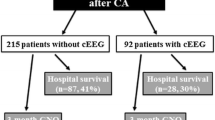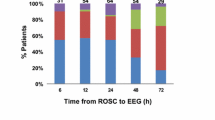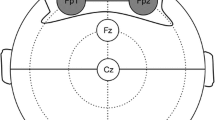Abstract
Background
Electroencephalographic (EEG) features may provide objective data regarding prognosis in children resuscitated from cardiac arrest (CA), but therapeutic hypothermia (TH) may impact its predictive value. We aimed to determine whether specific EEG features were predictive of short-term outcome in children treated with TH after CA, both during hypothermia and after return to normothermia.
Methods
Thirty-five children managed with a standard clinical TH algorithm after CA were prospectively enrolled. EEG recordings were scored in a standardized manner and categorized. EEG category 1 consisted of continuous and reactive tracings. EEG category 2 consisted of continuous but unreactive tracings. EEG category 3 included those with any degree of discontinuity, burst suppression, or lack of cerebral activity. The primary outcome was unfavorable short-term outcome defined as Pediatric Cerebral Performance Category score of 4–6 (severe disability, vegetative, death) at hospital discharge. Univariate analyses of the association between EEG category and outcome was performed using logistic regression.
Results
For tracings obtained during hypothermia, patients with EEGs in categories 2 or 3 were far more likely to have poor outcome than those in category 1 (OR 10.7, P = 0.023 and OR 35, P = 0.004, respectively). Similarly, for tracings obtained during normothermia, patients with EEGs in categories 2 or 3 were far more likely to have poor outcomes than those in category 1 (OR 27, P = 0.006 and OR 18, P = 0.02, respectively).
Conclusions
A simple EEG classification scheme has predictive value for short-term outcome in children undergoing TH after CA.
Similar content being viewed by others
References
Abend NS, Licht DJ. Predicting outcome in children with hypoxic ischemic encephalopathy. Pediatr Crit Care Med. 2008;9:32–9.
Wijdicks EF, Hijdra A, Young GB, Bassetti CL, Wiebe S. Practice parameter: prediction of outcome in comatose survivors after cardiopulmonary resuscitation (an evidence-based review): report of the Quality Standards Subcommittee of the American Academy of Neurology. Neurology. 2006;67:203–10.
Roest A, van Bets B, Jorens PG, Baar I, Weyler J, Mercelis R. The prognostic value of the EEG in postanoxic coma. Neurocrit Care. 2009;10:318–25.
Synek VM. Prognostically important EEG coma patterns in diffuse anoxic and traumatic encephalopathies in adults. J Clin Neurophysiol. 1988;5:161–74.
Young GB, McLachlan RS, Kreeft JH, Demelo JD. An electroencephalographic classification for coma. Can J Neurol Sci. 1997;24:320–5.
Nishisaki A, Sullivan J 3rd, Steger B, et al. Retrospective analysis of the prognostic value of electroencephalography patterns obtained in pediatric in-hospital cardiac arrest survivors during three years. Pediatr Crit Care Med. 2007;8:10–7.
Thenayan EA, Savard M, Sharpe MD, Norton L, Young B. Electroencephalogram for prognosis after cardiac arrest. J Crit Care. 2010;25:300–4.
Husain AM. Electroencephalographic assessment of coma. J Clin Neurophysiol. 2006;23:208–20.
Gerber PA, Chapman KE, Chung SS, et al. Interobserver agreement in the interpretation of EEG patterns in critically ill adults. J Clin Neurophysiol. 2008;25:241–9.
Hirsch LJ, Brenner RP, Drislane FW, et al. The ACNS subcommittee on research terminology for continuous EEG monitoring: proposed standardized terminology for rhythmic and periodic EEG patterns encountered in critically ill patients. J Clin Neurophysiol. 2005;22:128–35.
Ronner HE, Ponten SC, Stam CJ, Uitdehaag BM. Inter-observer variability of the EEG diagnosis of seizures in comatose patients. Seizure. 2009;18:257–63.
Abend NS, Gutierrez-Colina AM, Zhao H, et al. Interobserver reproducibility of electroencephalogram interpretation in critically ill children. J Clin Neurophysiol. (in press).
Bernard SA, Gray TW, Buist MD, et al. Treatment of comatose survivors of out-of-hospital cardiac arrest with induced hypothermia. N Engl J Med. 2002;346:557–63.
HACAS Group. Mild therapeutic hypothermia to improve the neurologic outcome after cardiac arrest. N Engl J Med. 2002;346:549–56.
Jacobs S, Hunt R, Tarnow-Mordi W, Inder T, Davis P. Cooling for newborns with hypoxic ischaemic encephalopathy. Cochrane Database Syst Rev. 2007:CD003311.
Shankaran S, Laptook AR, Ehrenkranz RA, et al. Whole-body hypothermia for neonates with hypoxic-ischemic encephalopathy. N Engl J Med. 2005;353:1574–84.
Gluckman PD, Wyatt JS, Azzopardi D, et al. Selective head cooling with mild systemic hypothermia after neonatal encephalopathy: multicentre randomised trial. Lancet. 2005;365:663–70.
Azzopardi DV, Strohm B, Edwards AD, et al. Moderate hypothermia to treat perinatal asphyxial encephalopathy. N Engl J Med. 2009;361:1349–58.
Topjian A, Hutchins L, Diliberto M, et al. Induction and maintenance of therapeutic hypothermia after pediatric cardiac arrest: efficacy of a surface cooling protocol. Pediatr Crit Care Med. doi:10.1097/PCC.0b013e3181e28717.
Fink EL, Clark RS, Kochanek PM, Bell MJ, Watson RS. A tertiary care center’s experience with therapeutic hypothermia after pediatric cardiac arrest. Pediatr Crit Care Med. 2010;11:66–74.
Stecker MM, Cheung AT, Pochettino A, et al. Deep hypothermic circulatory arrest: I. Effects of cooling on electroencephalogram and evoked potentials. Ann Thorac Surg. 2001;71:14–21.
Abend NS, Topjian A, Ichord R, et al. Electroencephalographic monitoring during hypothermia after pediatric cardiac arrest. Neurology. 2009;72:1931–40.
Rundgren M, Rosen I, Friberg H. Amplitude-integrated EEG (aEEG) predicts outcome after cardiac arrest and induced hypothermia. Intensive Care Med. 2006;32:836–42.
Fiser DH, Long N, Roberson PK, Hefley G, Zolten K, Brodie-Fowler M. Relationship of pediatric overall performance category and pediatric cerebral performance category scores at pediatric intensive care unit discharge with outcome measures collected at hospital discharge and 1- and 6-month follow-up assessments. Crit Care Med. 2000;28:2616–20.
DeLong ER, DeLong DM, Clarke-Pearson DL. Comparing the areas under two or more correlated receiver operating characteristic curves: a nonparametric approach. Biometrics. 1988;44:837–45.
Young GB. The EEG in coma. J Clin Neurophysiol. 2000;17:473–85.
Pampiglione G, Harden A. Resuscitation after cardiocirculatory arrest. Prognostic evaluation of early electroencephalographic findings. Lancet. 1968;1:1261–5.
Tasker RC, Boyd S, Harden A, Matthew DJ. Monitoring in non-traumatic coma. Part II: electroencephalography. Arch Dis Child. 1988;63:895–9.
Cheliout-Heraut F, Sale-Franque F, Hubert P, Bataille J. Cerebral anoxia in near-drowning of children. The prognostic value of EEG. Neurophysiol Clin. 1991;21:121–32.
Ramachandrannair R, Sharma R, Weiss SK, Cortez MA. Reactive EEG patterns in pediatric coma. Pediatr Neurol. 2005;33:345–9.
Mandel R, Martinot A, Delepoulle F, et al. Prediction of outcome after hypoxic-ischemic encephalopathy: a prospective clinical and electrophysiologic study. J Pediatr. 2002;141:45–50.
Pampiglione G, Chaloner J, Harden A, O’Brien J. Transitory ischemia/anoxia in young children and the prediction of quality of survival. Ann N Y Acad Sci. 1978;315:281–92.
Evans BM, Bartlett JR. Prediction of outcome in severe head injury based on recognition of sleep related activity in the polygraphic electroencephalogram. J Neurol Neurosurg Psychiatry. 1995;59:17–25.
Rossetti AO, Oddo M, Logroscino G, Kaplan PW. Prognostication after cardiac arrest and hypothermia: a prospective study. Ann Neurol. 2010;67:301–7.
Rossetti AO, Oddo M, Liaudet L, Kaplan PW. Predictors of awakening from postanoxic status epilepticus after therapeutic hypothermia. Neurology. 2009;72:744–9.
Leary M, Fried DA, Gaieski DF, et al. Neurologic prognostication and bispectral index monitoring after resuscitation from cardiac arrest. Resuscitation. 2010;81:1133–7.
Stammet P, Werer C, Mertens L, Lorang C, Hemmer M. Bispectral index (BIS) helps predicting bad neurological outcome in comatose survivors after cardiac arrest and induced therapeutic hypothermia. Resuscitation. 2009;80:437–42.
Seder DB, Fraser GL, Robbins T, Libby L, Riker RR. The bispectral index and suppression ratio are very early predictors of neurological outcome during therapeutic hypothermia after cardiac arrest. Intensive Care Med. 2010;36:281–8.
Wennervirta JE, Ermes MJ, Tiainen SM, et al. Hypothermia-treated cardiac arrest patients with good neurological outcome differ early in quantitative variables of EEG suppression and epileptiform activity. Crit Care Med. 2009;37:2427–35.
Legriel S, Bruneel F, Sediri H, et al. Early EEG monitoring for detecting postanoxic status epilepticus during therapeutic hypothermia: a pilot study. Neurocrit Care. 2009;11:338–44.
Acknowledgment
This work is supported by the NINDS Neurological Sciences Academic Development Award (NSADA) NS049453 to Drs. Abend and Kessler, the Penn Alliance for Therapeutic Hypothermia (University of Pennsylvania Comprehensive Neuroscience Center) to Drs. Abend, Topjian, Clancy, Dlugos, Nadkarni, and Ichord, and by the University of Pennsylvania Clinical Translational Research Center Grant (UL1-RR-024134) to Drs. Topjian and Nadkarni.
Author information
Authors and Affiliations
Corresponding author
Rights and permissions
About this article
Cite this article
Kessler, S.K., Topjian, A.A., Gutierrez-Colina, A.M. et al. Short-Term Outcome Prediction by Electroencephalographic Features in Children Treated with Therapeutic Hypothermia After Cardiac Arrest. Neurocrit Care 14, 37–43 (2011). https://doi.org/10.1007/s12028-010-9450-2
Published:
Issue Date:
DOI: https://doi.org/10.1007/s12028-010-9450-2




